The 5,000-year-old Pyramid City of Caral
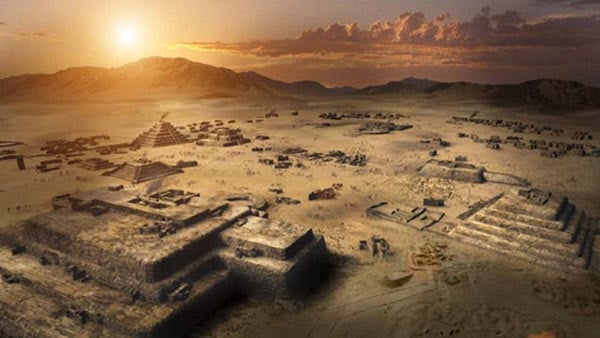
The
ancient city of Caral. Image source.
It is widely taught in the field of ancient history that Mesopotamia, Egypt, China, and India, gave rise to the first civilizations of mankind. However, few are aware that at the same time, and in some cases before some of these societies emerged, another great civilization had sprouted - the Norte Chico civilization of Supe, Peru – the first known civilization of the Americas. Their capital was the Sacred City of Caral – a 5,000-year-old metropolis complete with complex agricultural practices, rich culture, and monumental architecture, including six large pyramidal structures, stone and earthen platform mounds, temples, amphitheatre, sunken circular plazas, and residential areas.
The Supe Valley, which lies 200 miles north of Lima on the Peruvian Pacific coast, was surveyed in 1905 by the German archaeologist Max Uhle, who revealed the first archaeological discoveries in the area. However, it was not until several decades later that full-scale excavations took place, revealing the tip of a very large iceberg. In the 1970s, archaeologists discovered that the hills originally identified as natural formations were actually stepped pyramids, and by the 1990s the full extent of the great city of Caral had emerged. But another great surprise was yet to come – in the year 2000, radiocarbon dating carried out on reed carrying bags found at the site revealed that Caral dated back to the Late Archaic period beginning around 3,000 BC. Caral had now provided the most extensive evidence of an early complex society in the Americas.
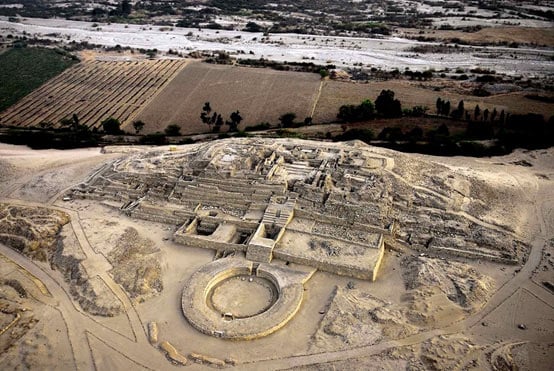
The remains of the Sacred City of Caral,
Peru. Image source.
Caral is one of 18 settlements identified in the Supe valley, covering an area of around 65 hectares. It is situated on a dry desert terrace overlooking the lush valley of the Supe River. Exceptionally well-preserved, the site is impressive in terms of its design and the complexity of its architecture. The city’s plan and some of its features, including pyramidal structures and residences of the elite, show clear evidence of ceremonial functions, signifying a powerful religious ideology.
The centre of the Caral complex consists of a central public area with six large pyramids (platform mounds) arranged around a huge plaza. The largest of the mounds, located in a dominating position within the urban plan of Caral, is 60 feet high and measures 450 x 500 feet at the base, covering an area nearly the size of four football fields. From the top of the great pyramid, the rulers of Caral would have been able to monitor the entire city. A 29-foot wide staircase opens into a series of small rooms, which include an atrium and a sacred altar. The altar room has a small hole in the floor, in which it appears that offerings were once burned.
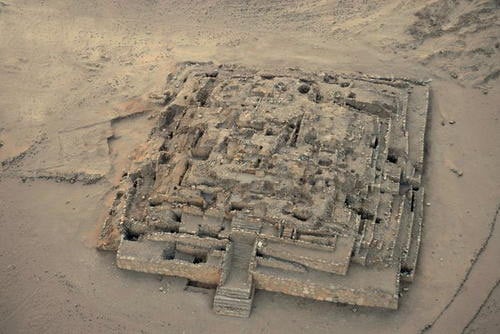
Remains of the Great Pyramid of Caral. Image
source: Christopher
Kleihege / UNESCO
In 2001, the Sacred City of Caral in Supe was inscribed on UNESCO’s World Heritage List. UNESCO writes:
“The Sacred City of Caral-Supe reflects the rise of civilisation in the Americas. As a fully developed socio-political state, it is remarkable for its complexity and its impact on developing settlements throughout the Supe Valley and beyond… The design of both the architectural and spatial components of the city is masterful, and the monumental platform mounds and recessed circular courts are powerful and influential expressions of a consolidated state.”
Unique artifacts shed light on daily life in 5,000-year-old city of Caral
The Sacred City of Caral is a 5,000-year-old metropolis which represents the oldest known civilization in the Americas, known as the Norte Chico. When it was first discovered, archaeologists had no idea of the extent of this great city, nor its age. It took some 90 years before researchers discovered its immense significance.
While the inhabitants of Caral lacked ceramics and limited art, they built huge monuments, including pyramids, plazas, amphitheatres, temples, and residential areas, had extensive agriculture, ate a varied diet, developed the use of textiles, used a complex system for calculating and recording, built water supply, and developed an intricate irrigation system. They traded widely with neighbouring societies, reaching at least as far as the Amazon jungle, as evidenced by carvings of monkeys.
Interestingly, no evidence of warfare has ever been found in Caral – no defensive structures, no weapons, and no bodies with violent injuries. Archaeologists believe the people of Caral were a peaceful culture who spent considerable time studying the heavens, practicing their religion and playing musical instruments.
The finely crafted flutes of Caral
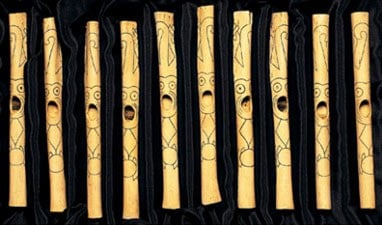
A selection of the flutes found at Caral. Image source.
The instruments are decorated with engraved figures, including monkeys, supernatural birds that combine features of some other creatures such as felines or monkeys, bird-faced snakes, a double head comprising a bird and a snake, and two anthropomorphic figures. They were played by blowing into the central hole and covering either the left or right hand holes.
In 2001, researchers held the Archaeo-Musicological Research Workshop for the Flutes of Caral, in a bid to reproduce the sound of each one of them, just as the ancient dwellers might have heard them millennia ago.
The ancient mathematical and recording system
of Caral
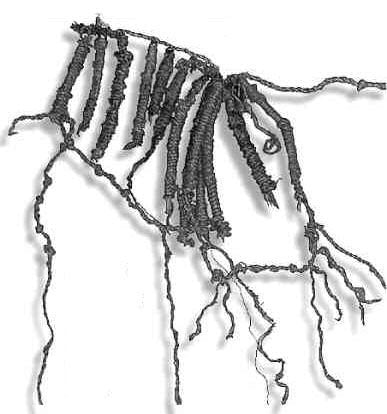
The quipu found in Caral. Image source.
Until the discovery of the quipu in Caral, no other examples had been found that dated back earlier than 650 AD. So the significance of this finding was that it was now apparent that inhabitants of Andean South America were using this complex recording system thousands of years earlier than they initially thought.
Time-keeping in Caral – the Monolith Huanca
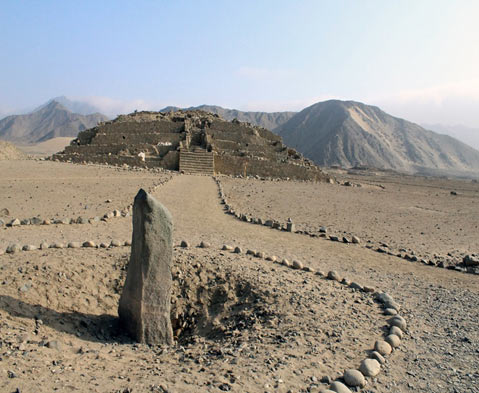
The monolith Huanca in Caral. Image source.
Religion and spiritual beliefs
There is one artefact that may serve to shed light on the beliefs of the Norte Chicos. Etched onto the side of a gourd (a hard seed pod used for carrying water), which dates to 2280-2180 BC, is a depiction of a sharp-toothed, hat-wearing figure who holds a long stick or rod in each hand, which has been named the Staff God.
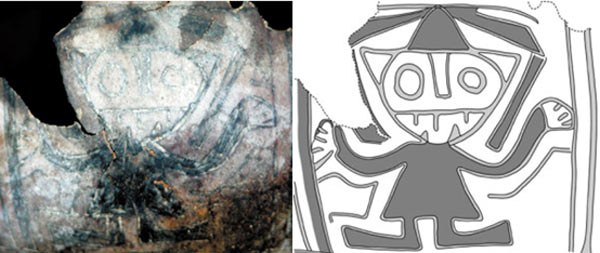
Left: The Staff God on the side of the gourd.
Credit: Jonathon Haas. Right: An outline showing the Staff God more clearly.
Credit: Jill Seaguard
Interestingly, the same image of the Staff God appears on pottery urns of the Wari and Tiwanaku cultures dating from 1,000 BC, all the way through to 1,000 AD, and the deity is figured prominently on the Gateway of the Sun at Tiwanaku near Lake Titicaca. Could beliefs in a Staff God have begun with the Norte Chico civilization in Caral nearly 5,000 years ago and dispersed outwards to influence later civilizations?
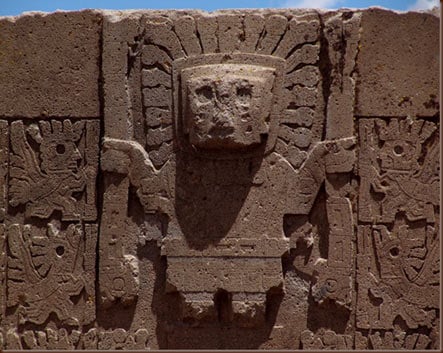
Staff God on the Gateway of the Sun at
Tiwanaku. It bears remarkable similarity to the deity depicted on the gourd
found in Caral. Image source.
For an unknown reason, Caral was abandoned rapidly after a period of only 500 years. It is believed that climate changes forced the inhabitants to find a new location for their city, although where exactly they went is uncertain. However, the fact that the Staff God, and the use of the quipu is found some 2,000 years later in other locations throughout South America, suggests that the Norte Chicos took with them their rich culture, religion, technology, and practices, and came to influence some of the greatest civilizations followed over the next 4,000 years.
Exploring the oldest civilization in the Americas – Goshen College
Oldest evidence of Andean religion found - Nature
Sacred City of Caral-Supe - UNESCO
Caral: the oldest town in the New World – Philip Coppens
Caral, the oldest city in America – Go2Peru
Caral: (Pyramid Complex) – Ancient-Wisdom
From Ancient Origins @ http://www.ancient-origins.net/ancient-places-americas/5000-year-old-pyramid-city-caral-002016
and http://www.ancient-origins.net/ancient-places-americas/unique-artifacts-shed-light-daily-life-5000-year-old-city-caral-002019
For more information about lost civilisations see http://nexusilluminati.blogspot.com/search/label/lost%20civilisation
- Scroll down
through ‘Older Posts’ at the end of each section
Hope you like this
not for profit site -
It takes hours of work every day by
a genuinely incapacitated invalid to maintain, write, edit, research,
illustrate and publish this website from a tiny cabin in a remote forest
Like what we do? Please give anything
you can -
Contribute any amount and receive at
least one New Illuminati eBook!
(You can use a card
securely if you don’t use Paypal)
Please click below -
Spare Bitcoin
change?
Xtra Images –
Video -
For further enlightening
information enter a word or phrase into the random synchronistic search box @
the top left of http://nexusilluminati.blogspot.com
And see
New Illuminati – http://nexusilluminati.blogspot.com
New Illuminati on Facebook - https://www.facebook.com/the.new.illuminati
New Illuminati Youtube Channel - http://www.youtube.com/user/newilluminati
New Illuminati on Google+ @ https://plus.google.com/115562482213600937809/posts
New Illuminati on Twitter @ www.twitter.com/new_illuminati
New Illuminations –Art(icles) by
R. Ayana @ http://newilluminations.blogspot.com
The Her(m)etic Hermit - http://hermetic.blog.com
DISGRUNTLED SITE ADMINS PLEASE NOTE –
We provide a live link to your original material on your site (and
links via social networking services) - which raises your ranking on search
engines and helps spread your info further!
This site is published under Creative Commons (Attribution) CopyRIGHT
(unless an individual article or other item is declared otherwise by the copyright
holder). Reproduction for non-profit use is permitted
& encouraged - if you give attribution to the work & author and include
all links in the original (along with this or a similar notice).
Feel free to make non-commercial hard (printed) or software copies or
mirror sites - you never know how long something will stay glued to the web –
but remember attribution!
If you like what you see, please send a donation (no amount is too
small or too large) or leave a comment – and thanks for reading this far…
Live long and prosper! Together we can create the best of all possible
worlds…
From the New Illuminati – http://nexusilluminati.blogspot.com
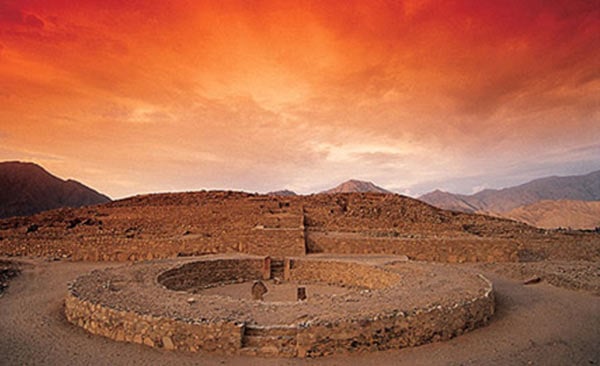
No comments:
Post a Comment
Add your perspective to the conscious collective